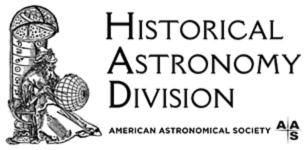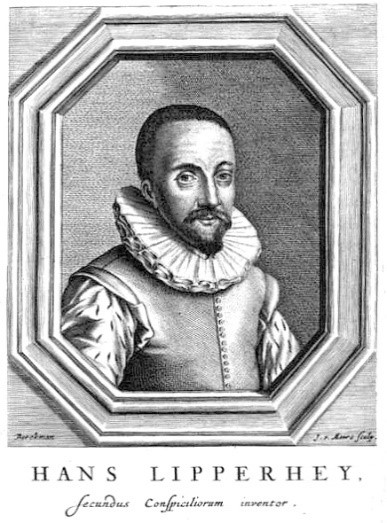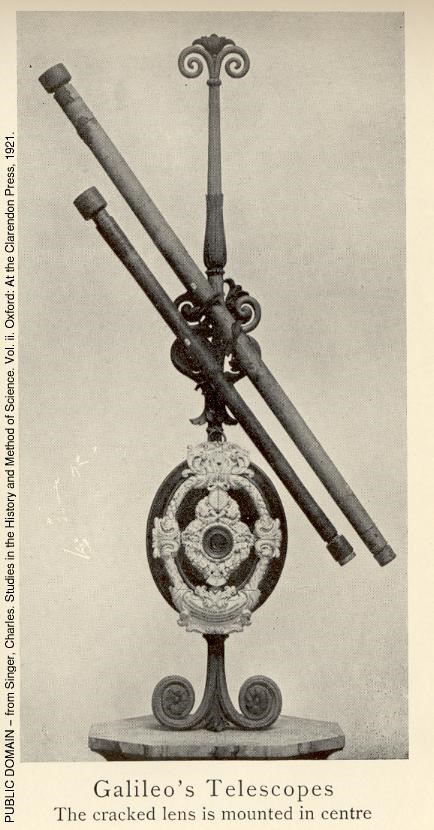This Month in Astronomical History: The Invention of the Telescope
Teresa Wilson United States Naval Observatory
 Each month as part of this new series from the Historical Astronomy Division of the AAS, an important discovery or memorable event in the history of astronomy will be highlighted. This month, we look at the discovery of Neptune
Each month as part of this new series from the Historical Astronomy Division of the AAS, an important discovery or memorable event in the history of astronomy will be highlighted. This month, we look at the discovery of Neptune
 The inventor of the refracting telescope is unknown, but the accomplishment is often attributed to the man who first filed a patent for it: Hans Lippershey (or Lipperhey), a 16th century Dutch eyeglass maker and inventor from Middelburg. Incidentally, the stories of his inspiration for building the instrument vary and tend to discredit his originality. In one scenario, two children were playing with optical lenses in his shop and he overheard them remark that a distant weather vane appeared closer when they looked through a pair of different lenses. In others, he took credit for the work of his assistant, or stole the idea from a third party altogether.
The inventor of the refracting telescope is unknown, but the accomplishment is often attributed to the man who first filed a patent for it: Hans Lippershey (or Lipperhey), a 16th century Dutch eyeglass maker and inventor from Middelburg. Incidentally, the stories of his inspiration for building the instrument vary and tend to discredit his originality. In one scenario, two children were playing with optical lenses in his shop and he overheard them remark that a distant weather vane appeared closer when they looked through a pair of different lenses. In others, he took credit for the work of his assistant, or stole the idea from a third party altogether.
Regardless of how events transpired, Lippershey filed for a 30-year patent from the States General of the Netherlands on 2 October 1608, creating the first written record for an instrument “for seeing things far away as if they were near.” As an alternative to the patent, he suggested a generous pension to compensate him for income he might otherwise have from selling his invention to foreign kings. Only weeks later, a lens maker from Alkmaar in North Holland, Jacob Metius, applied for a patent on a similar design. Zacharias Jansen, another eyeglass maker from Middelburg and purported inventor of the compound microscope, is also claimed to have invented the telescope. Ultimately, Lippershey and Metius were both turned down for the patent because the instrument was deemed too easy to reproduce, and therefore could not be kept secret. But the Dutch government paid Lippershey handsomely to develop several pairs of binoculars with similar capabilities.
 Accounts disagree on whether Lippershey’s original instrument was made with a convex and a concave lens providing an upright image, or two concave lenses providing an inverted image, but they agree that the instrument provided 3 times magnification of distant objects. The idea for the “Dutch perspective glass” spread quickly. Word reached Italy in 1609 and Galileo created his own modified version. By the end of the year, he had built a telescope that could magnify 20 times. He was the first to turn it skyward for a concerted series of astronomical observations. With his new instrument, Galileo discovered Jupiter’s four largest moons, observed the complete phases of Venus verifying the Copernican theory of the solar system, and observed sunspots.
Accounts disagree on whether Lippershey’s original instrument was made with a convex and a concave lens providing an upright image, or two concave lenses providing an inverted image, but they agree that the instrument provided 3 times magnification of distant objects. The idea for the “Dutch perspective glass” spread quickly. Word reached Italy in 1609 and Galileo created his own modified version. By the end of the year, he had built a telescope that could magnify 20 times. He was the first to turn it skyward for a concerted series of astronomical observations. With his new instrument, Galileo discovered Jupiter’s four largest moons, observed the complete phases of Venus verifying the Copernican theory of the solar system, and observed sunspots.
While Lippershey was unable to obtain a patent for his telescope in 1608, Alvan Clark of Cambridge, MA received one on 11 November 1851 for his unique design which simplified the eyepiece, allowing for easier access to the lenses. Clark founded the firm Alvan Clark and Sons in 1846, which ground lenses for some of the largest telescopes in the 19th century and built the largest telescope in the world five times.
Telescope development has come a long way from Lippershey’s original design. Astronomers now have access to ground-based reflecting telescopes that use mirrors instead of lenses, radio telescopes that opened new regions of the electromagnetic spectrum, and space-based telescopes that are free of the limits imposed by our atmosphere. In this era of modern mega-telescopes which can look so far back into the past of the universe, it is ironic that the inventor of astronomy’s most essential instrument might never be known for sure.
- King, H. 1955 The History of the Telescope. Courier Corporation
- Rudd, M. E. 1993 “The Long and the Short of It: Telescopes of the Seventeenth Century” Journal of the Antique Telescope Society. 4: 12-19
- Chapmann, A. 2008 “Thomas Harriot: the first telescopic astronomer” Journal of the British Astronomical Association. 118: 6 (315-325)
- Van Helden, A. 1977 “The Invention of the Telescope” Transactions of the American Philosophical Society. 67: 4
- Van Helden, A. et al. 2010 The Origins of the Telescope, KNAW Press, Amsterdam
Each month is an exciting new adventure into the archives of astronomical history, but before I continue any further, I would appreciate your feedback to ensure my writing is reaching the largest audience possible. Please participate in a brief questionnaire (approximately 10 minutes) about the style and content. You may also submit any suggestions for future topics. Thank you!

